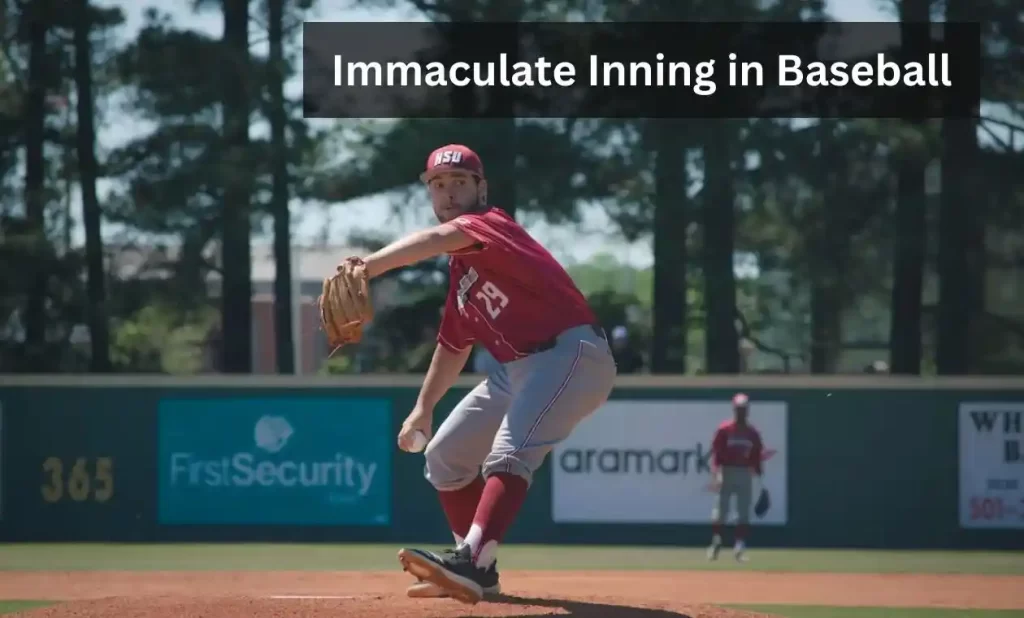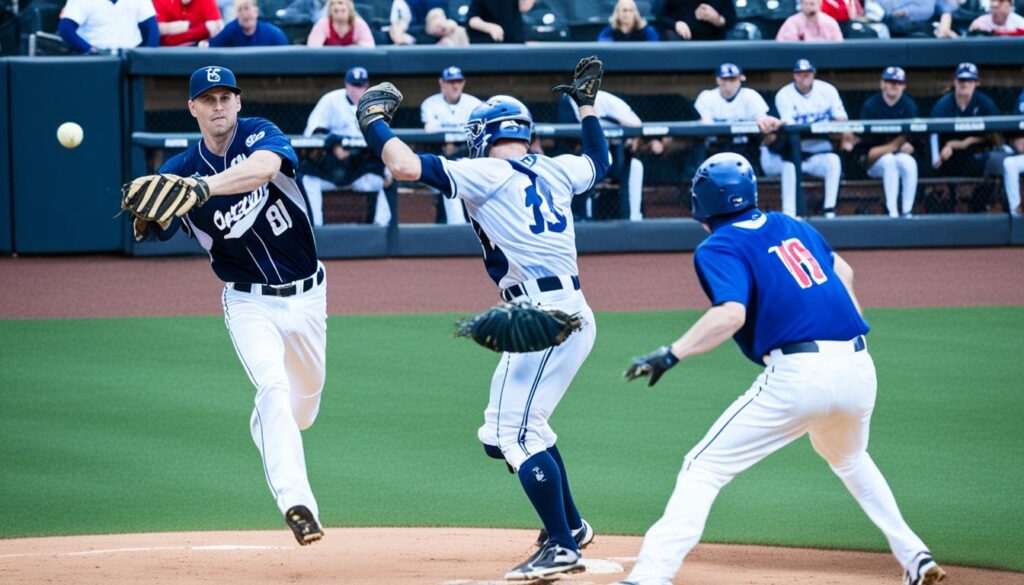
Welcome to the fascinating world of baseball statistics with MVR. Have you ever wondered what MVR means in baseball? Or what significance it holds in evaluating player performance and team strategy? Prepare to be amazed as we unravel the mysteries of MVR and explore its impact on the game.
- MVR stands for “Most Valuable Runner” in baseball.
- It is a crucial stat that evaluates player performance and contributions on the basepaths.
- MVR has a history in baseball and plays a significant role in understanding player value and team strategy.
- Join us on this journey as we dive deep into the calculations, significance, and misconceptions surrounding MVR.
- Uncover the secrets behind MVR and discover how it shapes the game we love.
What Is MVR in Baseball?
MVR stands for “Most Valuable Runner” in baseball. It is a special stat that helps evaluate player performance and contributions on the basepaths. MVR has a history in baseball and plays a crucial role in understanding player value and team strategy.
Baseball is a game of strategy and athleticism, and MVR captures the essence of a player’s base-running skills and impact on the game. It goes beyond traditional stats like batting average or RBIs, focusing specifically on a player’s ability to make a difference on the bases.
When a player excels in stealing bases, advancing on hits, or scoring runs, their MVR score increases. It highlights their ability to create scoring opportunities and put pressure on the opposing team’s defense.
“MVR is like a secret weapon that can turn a game around. It allows teams to capitalize on speed and base-running savvy, leading to more runs and ultimately more wins.”
Understanding MVR helps coaches, scouts, and fans appreciate the skill and value that players bring to the game beyond traditional performance metrics. It showcases the importance of speed, agility, and smart base-running decisions in shaping the outcomes of baseball matches.
The Significance of MVR in Baseball
Baseball is a dynamic sport where every run counts, and MVR provides a unique perspective on a player’s ability to contribute to their team’s success.
- MVR enables teams to evaluate base-running efficiency and identify players who excel at creating scoring opportunities.
- It enhances player evaluation, helping teams make informed decisions about player contracts, lineups, and roster construction.
- Coaches can use MVR as a strategic tool to exploit weaknesses in the opponent’s defense, putting pressure on their ability to control the basepaths.
Overall, MVR offers a comprehensive view of a player’s base-running skills and their impact on the game. It is an essential stat that enriches the understanding and appreciation of baseball performance, one base at a time.
How Is MVR Calculated?
MVR, an abbreviation for “Most Valuable Runner,” is an essential statistic in baseball that quantifies a player’s base-running skills and their contributions to advancing bases and creating scoring opportunities. To determine a player’s MVR score, baseball stat wizards use a simple yet intriguing formula that takes into account several factors.
First, the calculation involves assessing a player’s ability to steal bases, a fundamental skill that showcases speed and agility on the field. Stolen bases indicate a player’s capability to advance to the next base successfully, putting pressure on the opposing team’s defense and increasing the chances of scoring.
Additionally, the MVR formula considers a player’s base advancement performance beyond stealing bases. It evaluates their ability to advance multiple bases on plays, such as taking an extra base on a single or advancing from first to third on a hit. These actions reveal a player’s instinctive decision-making, strategic thinking, and overall base-running prowess.
Furthermore, situational context plays a vital role in the MVR calculation. Baseball is a game of moments, where the situation on the field continuously changes. The formula takes into account the specific game scenario, such as the score, inning, number of outs, and the presence of other runners on the basepaths. These contextual factors provide valuable insights into a player’s ability to make the right decisions at critical junctures, creating optimal scoring opportunities for their team.
The MVR formula remains a well-guarded secret recipe, carefully crafted by baseball stat wizards. It combines stolen bases, base advancement, and situational context to determine a player’s MVR score, which ultimately reflects their value as a base-runner and their contribution to their team’s success.
Calculating MVR is like uncovering the hidden layers of a player’s base-running brilliance. It’s a formula that reveals the magic behind a player’s success on the basepaths.
MVR vs. Other Baseball Stats
When it comes to baseball stats, MVR stands out as a unique metric that focuses specifically on a player’s value on the basepaths. While other stats like batting average and RBIs provide valuable insights into different aspects of the game, comparing MVR to these traditional stats is like comparing apples to oranges.
Batting average, for example, measures a player’s success at getting a hit relative to their total number of at-bats. It showcases a player’s ability to connect with the ball and reach base, but it doesn’t take into account their base-running skills or their impact on creating scoring opportunities.
RBI, on the other hand, reflects a player’s ability to drive in runs by advancing teammates already on base. It focuses on a player’s performance with runners in scoring position and demonstrates their ability to come through in clutch situations. However, it doesn’t capture a player’s overall contributions on the basepaths or their ability to advance and score runs.
MVR, in contrast, offers a comprehensive look at a player’s base-running skills, stolen bases, base advancement, and overall impact on creating scoring opportunities. It reveals insights that go beyond traditional stats and provides a more holistic understanding of a player’s value on the field.
While each stat has its own significance, MVR adds a unique layer of analysis to player performance evaluations. It complements other stats by shining a light on a crucial aspect of the game that is often overlooked.
Just like in life, different stats serve different purposes in baseball. MVR captures the essence of a player’s base-running prowess, while batting average and RBIs focus on different aspects. It’s the combination of these stats that gives us a well-rounded understanding of player performance.
So, the next time you dive into baseball stats, remember to consider the individual strengths and limitations of each metric. By embracing the diversity of stats like MVR, batting average, and RBIs, you’ll gain a more comprehensive view of a player’s skills and contributions on the field.

Significance of MVR in Player Performance
MVR, or Most Valuable Runner, holds significant importance in evaluating a player’s performance and contribution to the game. It goes beyond traditional baseball statistics and focuses on a player’s base-running skills, ability to advance bases, and their impact on creating scoring opportunities.
By analyzing MVR baseball stats, coaches, scouts, and team managers can gain unique insights into a player’s overall value and effectiveness on the field. MVR allows them to assess a player’s ability to generate runs, apply pressure on the opposing team’s defense, and contribute significantly to a team’s success.
Player evaluation goes beyond just batting averages or RBIs, as MVR offers a comprehensive assessment of athletes’ skills and performance. It measures a player’s speed, agility, and baserunning instincts, providing a deeper understanding of their impact on the game.
Additionally, MVR plays a significant role in the negotiation of player contracts. A high MVR score showcases a player’s versatility and value to a team, making them more attractive to potential suitors. Contracts may consider MVR as a determining factor in evaluating an athlete’s worth and potential impact on team strategy.
Speaking of team strategy, MVR also influences how teams craft their game plans. Coaches and managers analyze MVR data to design offensive strategies, positioning their players advantageously on the bases, and harnessing their base-running abilities. Understanding the strengths and weaknesses of each player’s MVR allows teams to optimize their scoring opportunities and gain a competitive edge.
Using MVR baseball stats to evaluate player performance offers a comprehensive perspective on an athlete’s value beyond traditional statistics. It showcases their base-running skills, contribution to creating scoring opportunities, and overall effectiveness on the field. Moreover, MVR impacts player contracts and shapes team strategy, making it a crucial element in the world of baseball.
Now, let’s dive deeper into common misconceptions about MVR and dispel some myths surrounding this fascinating baseball statistic.
Stay tuned for Section 6: Common Misconceptions about MVR
Common Misconceptions about MVR
As with any aspect of baseball, there are bound to be misconceptions and myths surrounding MVR. It’s important to separate fact from fiction and gain a deeper understanding of the true meaning and significance of MVR in the game.
One common myth is that MVR is solely based on stolen bases. While stolen bases are a factor in calculating MVR, they are not the sole determinant. MVR takes into account various base-running skills and contributions, such as base advancement and situational context, to provide a comprehensive evaluation of a player’s performance on the basepaths.
“MVR is more than just stolen bases. It captures the essence of a player’s ability to create scoring opportunities and impact the game through strategic base-running.” – Baseball Analyst
Another misconception is that MVR is only relevant for fast players. While speed can certainly be an advantage when it comes to base-running, MVR looks beyond speed alone. It considers a player’s ability to make smart decisions, read the game, and seize opportunities to advance bases effectively.
It’s also important to note that MVR is not a standalone statistic. It works in conjunction with other baseball stats to provide a comprehensive evaluation of a player’s overall performance and value to the team.
By dispelling these misconceptions surrounding MVR, we can gain a clearer understanding of its true role and impact in the game. MVR is a multifaceted stat that goes beyond simple metrics, capturing the nuances of base-running prowess. It offers valuable insights into a player’s strategic contributions and overall value to their team’s success.
How to Improve MVR
Improving your MVR (Most Valuable Runner) stats in baseball is essential for maximizing your contributions on the basepaths. By focusing on specific strategies and techniques, both players and teams can boost their MVR performance and make a greater impact on the game.
1. Develop Base-Running Skills
Enhancing your base-running skills is crucial for improving your MVR stats. Work on your agility, speed, and technique to become a more efficient runner. Practice sprinting, sliding, and rounding the bases to gain an edge over the competition. Remember, every split second counts when it comes to advancing bases and creating scoring opportunities.
2. Steal Bases Strategically
Stealing bases is a powerful tactic to improve your MVR stats. Study the opposing pitcher’s moves, timing his delivery, and pick the right moment to make your move. Keep an eye on the catcher’s arm strength and accuracy to increase your chances of success. With a well-timed steal, you can swiftly advance bases and boost your MVR impact.
3. Advance Bases Smartly
Advancing bases intelligently is crucial for improving your MVR stats. Pay attention to the game situation and make smart decisions when running the bases. Anticipate opportunities to take an extra base on a hit or capitalize on a fielding error. By being alert and decisive, you can contribute to scoring opportunities and increase your MVR score.
“Improving your MVR stats requires a combination of skill, intelligence, and strategy. Baseball is a game of inches, and every small advantage on the basepaths can make a significant difference in the game’s outcome.”
4. Craft Strategies with Coaches and Teams
Collaborate with your coaches and teammates to develop effective strategies that maximize MVR contributions. Analyze the strengths and weaknesses of your opponents’ defense and identify areas where you can exploit gaps and create scoring opportunities. By working together and implementing well-thought-out tactics, you can elevate your MVR performance as a team.
- Coordinate hit-and-run plays
- Deploy sacrifice bunts
- Engage in double steal situations
Remember, teamwork and coordination are key to executing successful MVR strategies.
By implementing these strategies and techniques, you can improve your MVR stats and have a greater impact on the game. Keep refining your base-running skills, stealing bases strategically, advancing bases smartly, and collaborating with your coaches and teammates. Embrace the challenge and strive for excellence in enhancing your MVR performance.
Conclusion
MVR is an essential statistic in the world of baseball, providing valuable insights into player performance and team strategies. It evaluates a player’s base-running skills, their contributions to creating scoring opportunities, and their overall value to the team. Understanding MVR and its significance allows players and teams to make informed decisions that can lead to improvements in their game.
By embracing the magic of MVR, players can focus on enhancing their base-running skills, stealing bases, and advancing bases to boost their MVR stats. Coaches and teams can also develop strategies that maximize MVR contributions, ultimately increasing their chances of success on the field.
So, dive into the fascinating world of baseball statistics and explore the power of MVR. Unlock the secrets hidden within this crucial stat, and discover new ways to evaluate player performance and optimize team strategies. With MVR, the possibilities are endless, and the game of baseball becomes even more captivating.

Meet Daniel Anderson, the heart and soul behind Baseball Pro Picks. At 49, Daniel’s life has revolved around baseball, a passion that’s as strong today as it was when he first fell in love with the game. Living in the USA, Daniel has dedicated countless hours to watching, analyzing, and understanding every pitch, hit, and home run, making almost no game missed. His deep-rooted love for the sport is matched only by his commitment to sharing insightful, expert analysis with fellow baseball enthusiasts. With decades of experience and a keen eye for the game’s nuances, Daniel brings a unique perspective that enriches Baseball Pro Picks. Trust Daniel to guide you through the intricacies of baseball with the authority and trustworthiness of a true aficionado.













